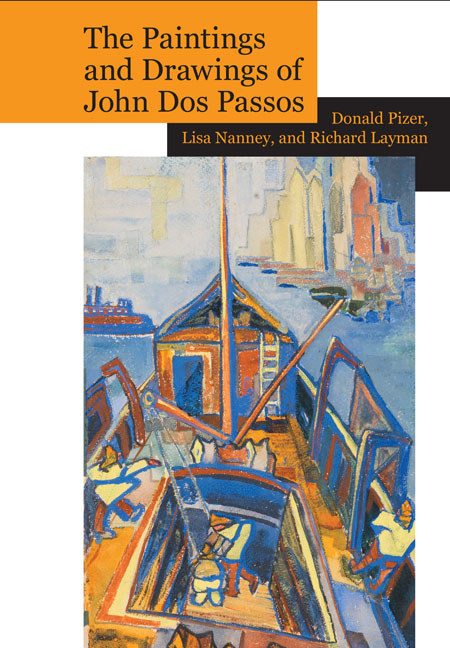Book contents
- Frontmatter
- Contents
- Preface
- Acknowledgments
- The Paintings and Drawings of John Dos Passos: A Collection and Study
- Introduction
- Paintings and Drawings Included in this Volume: A Descriptive List
- Preface to Section 1: Early Work 1918–20
- Preface to Section 2: The Middle East and Morocco 1921–22, 1926
- Preface to Section 3: Paris 1921–25
- Preface to Section 4: New York 1920–24
- Preface to Section 5: New York: Nudes 1920–23
- Preface to Section 6: Theater Designs 1925–28
- Preface to Section 7: Mexico 1926–32
- Preface to Section 8: Later Work 1930–70
- Preface to Section 9: Portraits
- Preface to Section 10: Sea Fronts and Harbors
- Preface to Section 11: Still Lifes
- Preface to Section 12: Studies in Motion
- Preface to Section 13: Abstractions and Other Experimental Modes
- Words and Images: The Visual Art of John Dos Passos
- The Artwork of John Dos Passos
- Notes
- Works Cited
- Index
- Plate section
Preface to Section 10: Sea Fronts and Harbors
from The Paintings and Drawings of John Dos Passos: A Collection and Study
- Frontmatter
- Contents
- Preface
- Acknowledgments
- The Paintings and Drawings of John Dos Passos: A Collection and Study
- Introduction
- Paintings and Drawings Included in this Volume: A Descriptive List
- Preface to Section 1: Early Work 1918–20
- Preface to Section 2: The Middle East and Morocco 1921–22, 1926
- Preface to Section 3: Paris 1921–25
- Preface to Section 4: New York 1920–24
- Preface to Section 5: New York: Nudes 1920–23
- Preface to Section 6: Theater Designs 1925–28
- Preface to Section 7: Mexico 1926–32
- Preface to Section 8: Later Work 1930–70
- Preface to Section 9: Portraits
- Preface to Section 10: Sea Fronts and Harbors
- Preface to Section 11: Still Lifes
- Preface to Section 12: Studies in Motion
- Preface to Section 13: Abstractions and Other Experimental Modes
- Words and Images: The Visual Art of John Dos Passos
- The Artwork of John Dos Passos
- Notes
- Works Cited
- Index
- Plate section
Summary
Many of Dos Passos's landscapes depict waterways, harbors, or seashores. This section's paintings are typical of those in their focus on forms of recreation or modes of transportation or industry dependent on waterways. The frequency of these motifs in Dos Passos's visual work, as their recurrence throughout this book attests, results in part from the immediacy of much of his painting: he captured the life around him as he did in his fiction, and he explored the settings and circumstances that shaped people's lives and work. Also, as Donald Pizer notes in his introduction, Dos Passos lived in places overlooking water much of his life—Brooklyn, Provincetown, and, later in life, by the Potomac River—and often traveled by ship. Thus his interest in visualizing the elemental forms, commercial activities, and social interactions of waterside locations was natural.
That fascination with the motion of waterborne commercial traffic emerges strongly in Dos Passos's numerous paintings of New York Harbor represented by this book's section on New York in the 1920s (figs. 20a, 22, 23). His related interest in studying in isolation the formal aspects of the machinery attendant upon that traffic is clear in figures 54a and 54b, the series of studies preparatory to figure 55, an image Dos Passos created for his translation of Blaise Cendrars's Le Panama et mes sept oncles (1931). Motivated by friendship with the avant-garde French poet and by admiration for his pioneering creations capturing the motion of modern life, Dos Passos translated his work and provided illustrations. He saw in Cendrars's “alive informal personal poems” an antidote to what he perceived as the trend toward effete elitism in poetry, especially in America. Understanding Cendrars's search for artistic methods to express “meaning in everyday life” (viii) as Dos Passos did in his fiction, he created images for Cendrars's book that reflected the essential formal dynamics in common work, as in the finished illustration (fig. 55) of a sailor painting shipboard machinery.
Dos Passos's working progression toward an image that evokes the essence of the sailor and his task originates with pencil sketches of the forms basic to the portrait—the round funnel mouth above the rounded parts of a pulley system with rope circling its base.
- Type
- Chapter
- Information
- Publisher: Liverpool University PressPrint publication year: 2016



